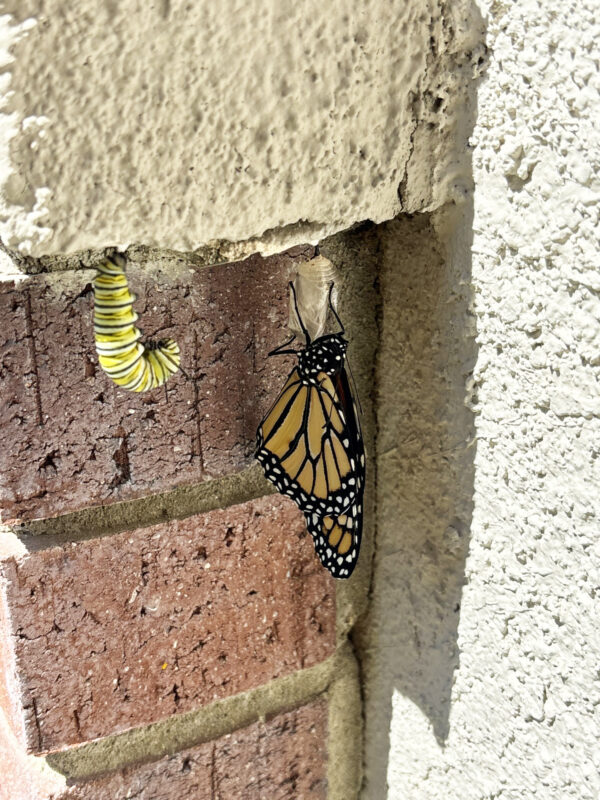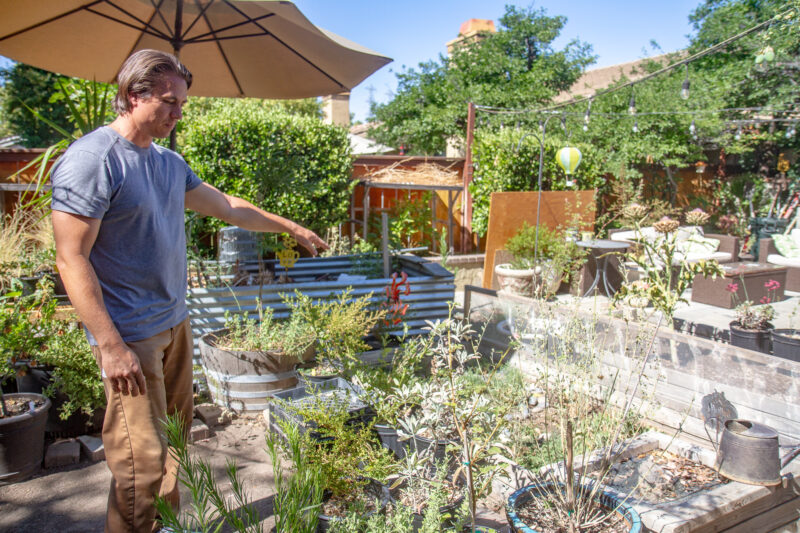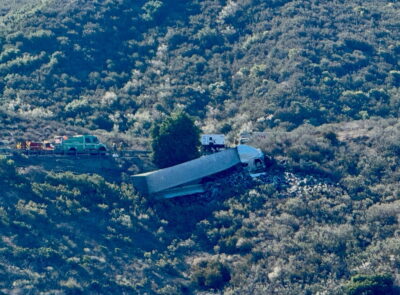Steven Fulton started out offering milkweed plants to support the endangered Western Monarch population. Today his Santa Clarita Native Plant Nursery showcases more than 200 California native plants, including the milkweed.
By Alicia Doyle
Sunday Signal Writer
On a sun-drenched street in Valencia, where suburban lawns usually blend into a sea of sameness, one native plant nursery bursts with wild color and fluttering wings. Here, you’ll find a man with a mission in his heart: to turn every yard into a butterfly haven. His secret? California native plants — and, most importantly, milkweed, the magical lifeline for monarchs. With every sale, he’s not just handing over a plant; he’s passing along the promise of transformation, inviting neighbors to watch caterpillars become butterflies in their own yards. “Attracting butterflies is as easy as planting a variety of plants, usually selecting host plants for the hungry caterpillars as well as plants that will provide nectar for the adult butterflies,” said Steven Fulton, founder of the Santa Clarita Native Plant Nursery. “It is often recommended when planting milkweed to have at least three plants and to have them in different areas.” The Santa Clarita Native Plant Nursery offers a variety of plants that are host plants, meaning they are food for caterpillars as well as plants that provide nectar for our native pollinators. “Monarchs, Painted Ladies, swallowtails, red admirals and California Dogface are a few of our favorite butterflies,” said Fulton, adding that moths — including the Ceanothus Silk Moth and White-lined Sphynx Moth, the big one that looks like a hummingbird — are also an important pollinator supported by native plants. What role does milkweed play in the life of a butterfly? “Milkweed is a host plant for monarchs, meaning it is the only plant a monarch will lay its eggs on,” Fulton explained. There are 16 varieties of milkweed native to California, he said, and in Santa Clarita, Narrowleaf, Kotolo and Showy milkweed are three common varieties that are suitable for our area. “Milkweed gets its name from the milky sap it exudes when a leaf or stem is damaged and weed portion was likely a contribution from farmers,” Fulton explained. “All milkweeds contain a cardenolide that some insects can consume. Monarch caterpillars retain this poison through adulthood. This is what makes them taste bad to predators.” The Santa Clarita Native Plant Nursery originally started by offering Narrowleaf and Showy Milkweed to help support the endangered Western Monarch population. “Now we offer a variety of plants that support a variety of local fauna,” said WFulton, noting that they carry a large variety of California native plants that are adapted to our climate. “I have certifications through Calscape, Theodore Payne, and Tree of Life Nursery.” Narrowleaf Milkweed — a California native milkweed found naturally occurring in our area — is one of his most popular offerings, “but we also offer a variety of solutions from groundcovers to bank stabilization.” Fulton has been in business for just over three years. “We started after my son did a report on monarchs and their endangered status,” remembered Fulton, whose son, Cruz, is now 15 and attends Hart High School. “He wrote the report in 6th grade at Valencia Valley Elementary; I believe it was for his English studies,” Fulton said. “I’m not sure how Cruz landed on monarchs as his subject, but he has always been into nature — I may have rubbed off on him with all my fruit and vegetable gardening.” His son’s report showed him that “there are so many interesting facts and behaviors of monarchs that I wasn’t aware of,” Fulton continued. “Did you know they smell with their feet? Ever seen a butterfly aerial dogfight?” Unfortunately, monarch butterflies are facing a dramatic decline, with populations in North America having dropped by more than 80% in central Mexico — and by more than 95% in California since the 1990s. This decline has led to their classification as vulnerable by the International Union for Conservation of Nature as of December 2023. In the United States, the U.S. Fish and Wildlife Service proposed in December 2024 to list monarchs as threatened under the Endangered Species Act. The main threats to monarchs include habitat loss due to agriculture and urbanization, widespread use of herbicides and pesticides, and the impacts of climate change. “Monarchs, and other butterflies, are a good indicator of the overall health of an ecosystem —they are a food source and pollinator,” Fulton said. “Also, when you work to preserve or restore the monarch’s habitat, you’re also doing the same for many more pollinators and wildlife species.” His ultimate goal with the butterflies is to raise awareness and contribute to the repopulation of our Western monarchs. “Our ultimate goal with our nursery is to showcase the beauty of our California native plants,” he added. “They support local fauna, can be drought tolerant which promotes water conservation, and are beautiful looking and smelling.” Their ideal customer is the home gardening enthusiast that enjoys nature. “We are a backyard based grower/retailer and the best way to reach us really depends,” Fulton said. If you know what you’re looking for, then text works best (661) 289-8296. If you’re looking to plan for a larger project, he recommends emailing him at [email protected]. Fulton can also be reached via messenger on Facebook atFacebook.com/SantaClaritaNative PlantNursery; or on Instagram at Instagram.com/SC_Native_Plant_Nursery.











